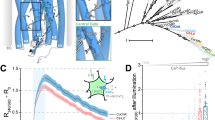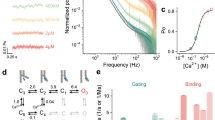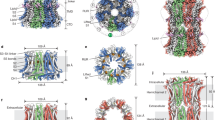Abstract
Calcium channels carry out vital functions in a wide variety of excitable cells1–4 but they also face special challenges. In the medium outside the channel, Ca2+ ions are vastly outnumbered by other ions. Thus, the calcium channel must be extremely selective if it is to allow Ca2+ influx rather than a general cation influx. In fact, calcium channels show a much greater selectivity for Ca2+ than sodium channels do for Na+ (refs 5–9) despite the high flux that open Ca channels can support3–4. Relatively little is known about the mechanism of ion permeation through Ca channels. Earlier models assumed ion independence5 or single-ion occupancy10–16. Here we present evidence for a novel hypothesis of ion movement through Ca channels, based on measurements of Ca channel activity at the level of single cells or single channels. Our results indicate that under physiological conditions, the channel is occupied almost continually by one or more Ca2+ ions which, by electrostatic repulsion, guard the channel against permeation by other ions. On the other hand, repulsion between Ca2+ ions allows high throughput rates and tends to prevent saturation with calcium.
This is a preview of subscription content, access via your institution
Access options
Subscribe to this journal
Receive 51 print issues and online access
$199.00 per year
only $3.90 per issue
Buy this article
- Purchase on Springer Link
- Instant access to full article PDF
Prices may be subject to local taxes which are calculated during checkout
Similar content being viewed by others
References
Hagiwara, S. & Byerly, L. A. Rev. Neurosci. 4, 69–125 (1981).
Kostyuk, P. G. Biochem. biophys. Acta 650, 128–150 (1981).
Tsien, R. W. A. Rev. Physiol. 45, 341–358 (1983).
Reuter, H. Nature 301, 569–574 (1983).
Reuter, H. & Scholz, H. J. Physiol., Lond. 264, 17–47 (1977).
Lee, K. S. & Tsien, R. W. Nature 497, 498–501 (1982).
Isenberg, G. Z. Naturf. 370, 502–512 (1982).
Matsuda, H., Noma, A. & Irisawa, H. Proc. int. Un. physiol. Sci. 15, 50 (1983).
Lee, K. S. & Tsien, R. W. J. Physiol., Lond. (submitted).
Vereecke, J. & Carmeliet, E. E. Pflügers Arch. ges. Physiol. 322, 73–82 (1971).
Hagiwara, S., Fukuda, J. & Eaton, D. C. J. gen. Physiol. 63, 564–578 (1974).
Akaike, N., Lee, K. S. & Brown, A. M. J. gen. Physiol. 71, 509–531 (1978).
Edwards, C. Neuroscience 7, 1335–1366 (1981).
Kostyuk, P. G., Mironov, S. L. & Doroshenko, P. A. J. Membrane Biol. 70, 181–189 (1982).
Ashcroft, F. M. & Stanfield, P. R. J. Physiol., Lond. 323, 93–115 (1982).
Kostyuk, P. G., Mironov, S. L. & Shuba, Ya. M. J. Membrane Biol. 76, 83–93 (1983).
Kao, R. L. et al. Archs Biochem. Biophys. 203, 587–599 (1980).
Lee, K. S., Akaike, N. & Brown, A. M. J. Neurosci. Meth. 2, 51–78 (1980).
Garnier, D., Rougier, O., Gargouil, Y. M. & Coraboeuf, E. Pflügers Arch. ges. Physiol. 313, 321–342 (1969).
Almers, W., McCleskey, E. W. & Palade, P. T. J. Physiol., Lord. 332, 52–53P (1982).
Andersen, O. S. Abstr. 5th int. Biophys. Congr., 112 (1975).
Neher, E. Biochim. biophys. Acta 401, 540–544 (1975).
Hagiwara, S., Miyazaki, S., Krasne, S. & Ciani, S. J. gen. Physiol. 70, 269–281 (1977).
Takeuchi, A. & Takeuchi, N. J. Physiol., Lond. 212, 337–351 (1971).
Hagiwara, S. & Takahashi, K. J. Physiol., Lond. 238, 109–127 (1974).
Eisenman, G., Sandblom, J. P. & Walker, J. L. Jr, Science 155, 965–974 (1967).
Urban, B. W., Hladky, S. B. & Haydon, D. A. Fedn Proc. 37, 2628–2632 (1978).
Hille, B. & Schwarz, W. J. gen. Physiol. 72, 409–442 (1978).
Sigworth, F. J. J. Physiol., Lond. 307, 97–129 (1980).
Hamill, O., Marty, A., Neher, E., Sakmann, B. & Sigworth, F. J. Pflügers Arch. ges. Physiol. 391, 85–100 (1981).
Bean, B. P., Nowycky, M. C. & Tsien, R. W. Nature 307, 371–375 (1984).
Begenisich, T. B. & Cahalan, M. D. J. Physiol., Lond. 307, 217–242 (1980).
Levitt, D. G. Biophys. J. 22, 209–219 (1978).
Hille, B. J. gen. Physiol. 66, 535–560 (1975).
Hess, P. & Tsien, R. W. Soc. Neurosci. Abstr. 9, 509 (1983).
Tsien, R. W., Bean, B. P., Hess, P. & Nowycky, M. C. Cold Spring Harb. Symp. quart. Biol. 48, 201–212 (1983).
Almers, W. & McCleskey, E. W. J. Physiol., Lond. (in the press).
Author information
Authors and Affiliations
Rights and permissions
About this article
Cite this article
Hess, P., Tsien, R. Mechanism of ion permeation through calcium channels. Nature 309, 453–456 (1984). https://doi.org/10.1038/309453a0
Received:
Accepted:
Issue Date:
DOI: https://doi.org/10.1038/309453a0
This article is cited by
-
The Ca2+ permeation mechanism of the ryanodine receptor revealed by a multi-site ion model
Nature Communications (2020)
-
Ion Permeation Mechanism in Epithelial Calcium Channel TRVP6
Scientific Reports (2018)
-
The chemical basis for electrical signaling
Nature Chemical Biology (2017)
-
The how and why of identifying the hair cell mechano-electrical transduction channel
Pflügers Archiv - European Journal of Physiology (2015)
-
Structural basis for Ca2+ selectivity of a voltage-gated calcium channel
Nature (2014)
Comments
By submitting a comment you agree to abide by our Terms and Community Guidelines. If you find something abusive or that does not comply with our terms or guidelines please flag it as inappropriate.



